Query Execution Study Note
Query execution is part of the query processor. The SQL query will be firstly compiled then be executed. A simple diagram shows clearly below.
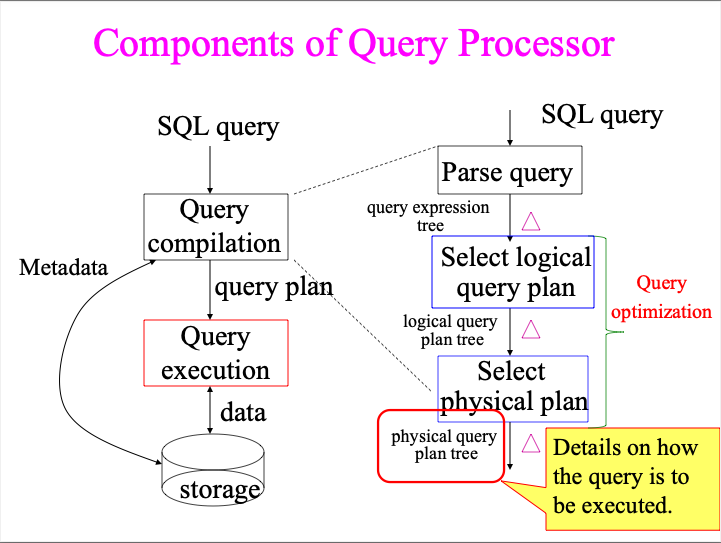
This note is mainly on query execution.
Table of Contents
- Table of Contents
- Cost Model
- Classification of Physical Operators
Cost Model
Why? And Some Assumptions
- Important in query optimization
- Here we consider I/O cost only
- We assume operands are relations stored on disk, but operator results will be left in main memory (e.g., pipelined to next operator in query plan)
- So we don’t include the cost of writing the result
We will also need some notations, aka, cost parameters.
Cost parameters
- $M$ = number of blocks/pages that are available in main memory
- $B(R)$ = number of blocks holding $R$
- $T(R)$ = number of tuples in $R$
- $V(R,a)$ = number of distinct values of the attribute $a$ of $R$
Two Types of Scanning Tables
Clustered
The table is clustered (i.e., block consists only of records from this table)
- # of I/O’s = # of blocks
Unclustered
The table is unclustered (e.g. its records are placed in blocks with those of other tables)
- May need one block read for each record

Cost of the Scan Operator
Clsutered relation
- We assume clustered relations to estimate the costs of other physical operators.
- Table scan: $B(R)$
Unclustered relation
- Table scan: $T(R)$
Classification of Physical Operators
One-pass Algorithms
Selection, $\sigma(R)$ and Projection, $\Pi(R)$
- Both are tuple-at-a-time algorithms
- Cost: $B(R)$
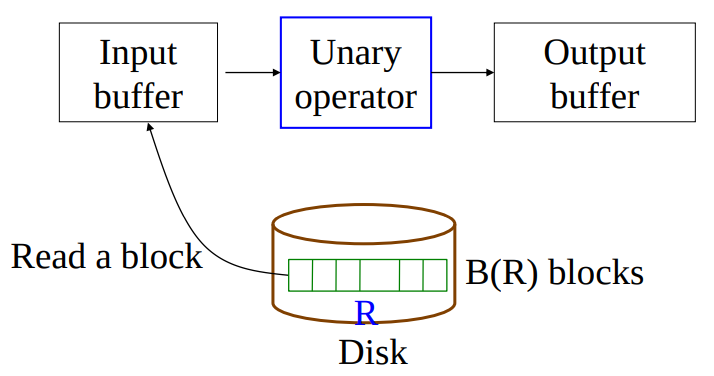
Duplicate elimination, $\delta(R)$
- Assumption: $B(\delta(R)) \le M-2$, or roughly $M$
- It needs to keep a dictionary in memory
- Balanced Search Tree (BST)
- Hash Table
- Etc.
- Cost: $B(R)$

Grouping, $\gamma_{\text{city, sum(price)}}(R)$
- Assumption: number of cities and sums fit in memory
- It also needs to keep a dictionary in memory
- In addition, it also stores the sum(price) for each city
- Cost: $B(R)$
Binary operations, $R\cap S, R\cup S, R-S, R\bowtie S$
- Assumption: $\text{min}(B(R), B(S)) \le M-2$, or roughly M
- Scan a smaller table of R and S into main memory, then read the other one, block by block
- Cost: $B(R)+B(S)$, assume both are clustered
- Example: $R\cap S$
- Assumption: set-based, no duplicates
- Read $S$ into $M-2$ buffers and build a search structure
- Read each block of $R$, and for each tuple $t$ of $R$, see if $t$ is also in $S$
- If so, copy $t$ to the output; if not, ignore $t$

Nested-Loop Join Algorithms
Tuple-based Nested Loop Joins
- $R\bowtie S$
- Assumption: Neither relation is clustered
- Pseudo-Python-Code
for r in R: # r is a tuple in R for s in S: # s is a tuple in S if canBeJoined(r,s): return (r,s) - Cost: $T(R)T(S)$
Block-based Nested Loop Joins
- $R\bowtie S$
- $R$ is the outer relation, $S$ is the inner relation
- Assumption
- Both relation are clustered
- $B(R) \le B(S)$ and $B(S) > M$
-
Pseudo-Python-Code
for br in R: # (M-2) blocks of br for bs in S: for r in br: # r is a tuple in R for s in bs: # s is a tuple in S if canBeJoined(r,s): return (r,s) -
Cost ($M\ge 3$ in order for $M-2\ge 1$)
- If R is the outer relation $$ B(R)+\frac{B(R)B(S)}{M-2} $$ where $B(R)$ is the cost of reading $R$ once, $\frac{B(R)}{M-2}$ is the number of outer loop runs. Each run needs to read $S$, so the latter is multiplied by $B(S)$.
- If S is the outer relation $$ B(S)+\frac{B(R)B(S)}{M-2} $$
- Takeaway: It is better to iterate over the smaller relation first
Two-pass Algorithms Based on Sorting
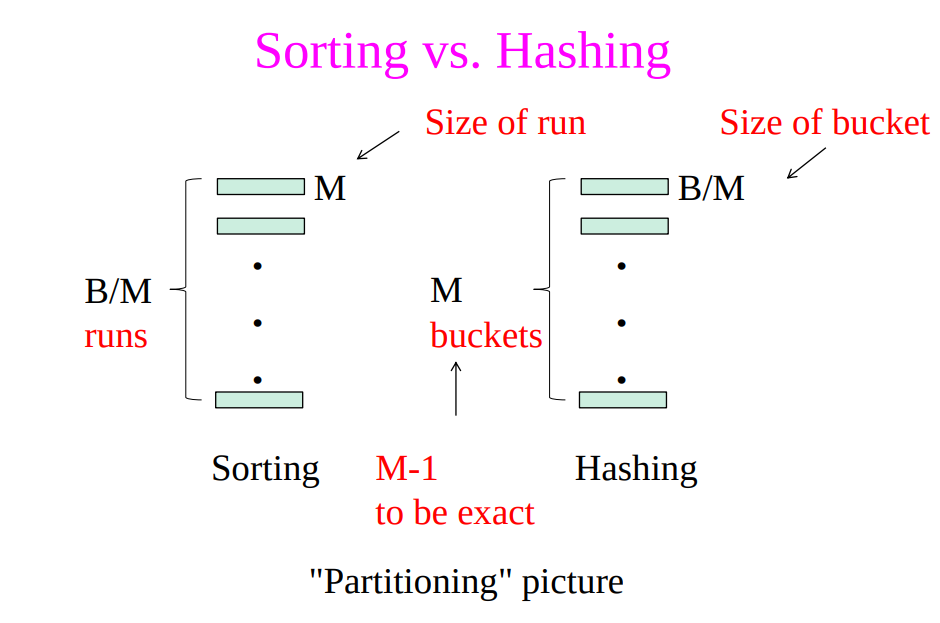
Sort-based vs. Hash-based Algorithms
- Sort-based algorithms sometimes allow us to produce a result in sorted order and take advantage of that sort later
- Hash-based algorithms for binary operations have a size requirement only on the smaller of two input relations
- Hash-based algorithm depends on the buckets being of equal size, which may not be true if data are skewed
Duplicate Elimination $\delta(R)$ Based on Sorting
- Idea: Sort first, then eliminate duplicates
- Assumption: $B(R) \le M^2$ (roughly)
- $B(R)/M$ is # of runs
- # of runs has to be smaller than or equal to $M-1$ to complete the merging in the second pass
- Therefore, $B(R)/M \le M-1$
- Steps
- Pass 1: sort runs of size $M$ and then write
- Cost: $2B(R)$
- Pass 2: merge $M-1$ runs, but include each tuple only once
- Cost: $B(R)$
- Pass 1: sort runs of size $M$ and then write
- Cost: $3B(R)$
Grouping $\gamma_{\text{city, sum(price)}}(R)$ Based on Sorting
- Assumption: $B(R) \le M^2$
- Steps
- Pass 1: sort runs of size $M$ and then write
- Cost: $2B(R)$
- Pass 2: merge $M-1$ runs, but include each tuple only once. Also, compute sum(price) for group during the merge phase (new compared to duplicate elimination based on sorting)
- Cost: $B(R)$
- Pass 1: sort runs of size $M$ and then write
- Cost: $3B(R)$
Binary operations $R\cap S, R\cup S, R-S$ Based on Sorting
Note that join operator ($\bowtie$) is not included this time. Why? Because there are a large number of tuples with the same value on the join attribute(s), however the buffer can not hold all joining tuples (with the same value on join attribute) for at least one relation.
- Idea: Sort $R$, sort $S$, then do their binary operations
- Assumption: $B(R)+B(S) \le M^2$ (roughly)
- Steps
- Pass 1: Split $R$ into runs of size $M$, then split $S$ into runs of size $M$
- Cost: $2B(R)+2B(S)$
- Pass 2: Merge $M-1$ runs from $R$ and $S$, then output a tuple on a case by cases basis
- Cost: $B(R)$
- Pass 1: Split $R$ into runs of size $M$, then split $S$ into runs of size $M$
- Cost: $3B(R)+3B(S)$

Sort-Merge Join
- Assumption:
- The buffer is enough to hold join tuples for at least one relation
- Note that the buffer also needs to hold a block for each run of the other relation
- $B(R)+B(S) \le M^2$ (roughly)
- The buffer is enough to hold join tuples for at least one relation
- Cost: $3B(R)+3B(S)$
Simple Sort-based Join
- Idea: Sort $R$, sort $S$, then do their binary operations
- Assumption: $B(R)\le M^2$, $B(S)\le M^2$, and at least one set of the tuples with a common value for the join attributes fit in $M$ (or $M-2$ to be exact)
- Note that we only need one page buffer for the other relation
- Steps
- Step 1: Start by completely sorting both $R$ and $S$ on the join attribute (assuming this can be done in 2 passes):
- Cost: $4B(R)+4B(S)$, because we need to write result to disk
- Step 2: Read both relations in sorted order, match tuples
- Cost: $B(R)+B(S)$
- Step 1: Start by completely sorting both $R$ and $S$ on the join attribute (assuming this can be done in 2 passes):
- Cost: $5B(R)+5B(S)$
- Note
- Can use as many buffers as possible to load join tuples from one relation (with the same join value), say $R$
- Only one buffer is needed for the other relation, say $S$
- If we still can not fit all join tuples from $R$
- Need to use nested loop algorithm, higher cost
- Can use as many buffers as possible to load join tuples from one relation (with the same join value), say $R$
Two-pass Algorithms Based on Hashing
Duplicate Elimination $\delta(R)$ Based on Hashing
- Idea
- Partition a relation R into buckets on disk. Each bucket has size approximately $B(R)/M$
- Does each bucket fit in main memory?
- Yes if $B(R)/(M-1) \le M-2$ (i.e., approx. $B(R) \le M^2$)
- Apply the one-pass duplicate elimination $\delta$ algorithm for each $R_i$
- Assumption: $B(R) \le M^2$ (roughly)
- Exact: $B(R)/(M-1) \le M-2$
- Steps
- Step 1: Partition $R$ into $M-1$ buckets
- Step 2: Apply $\delta$ to each bucket (must read it into main memory)
- Cost: $3B(R)$
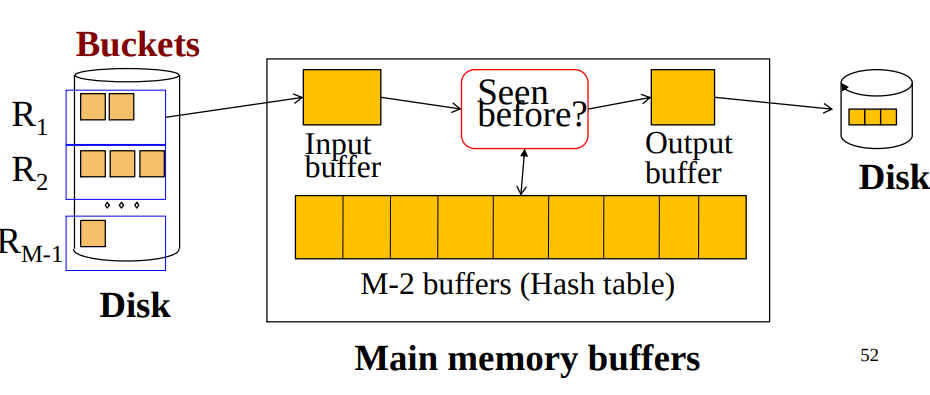
Partitioned Hash-Join
- Assumption: $\text{min}(B(R),B(S)) \le M^2$
- Exact: $\frac{\text{min}(B(R),B(S))}{M-1} \le M-3$
- If we don’t use hash table to speed up the lookup: $\frac{\text{min}(B(R),B(S))}{M-1} \le M-2$
- Steps
- Step 1
- Hash $S$ into $M$ - 1 bucket
- Send all buckets to disk
- Step 2
- Hash $R$ into $M$ - 1 bucket
- Send all buckets to disk
- Step 3
- Join every pair of corresponding buckets
- Step 1
- Cost: $3B(R)+3B(S)$
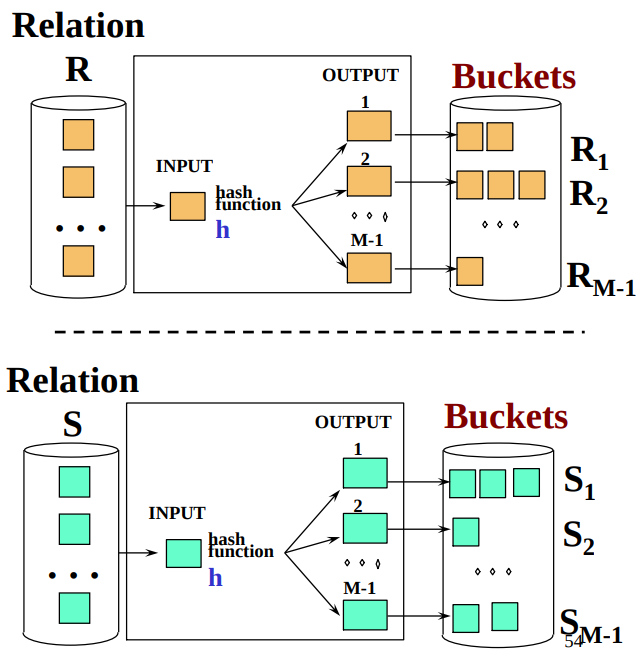
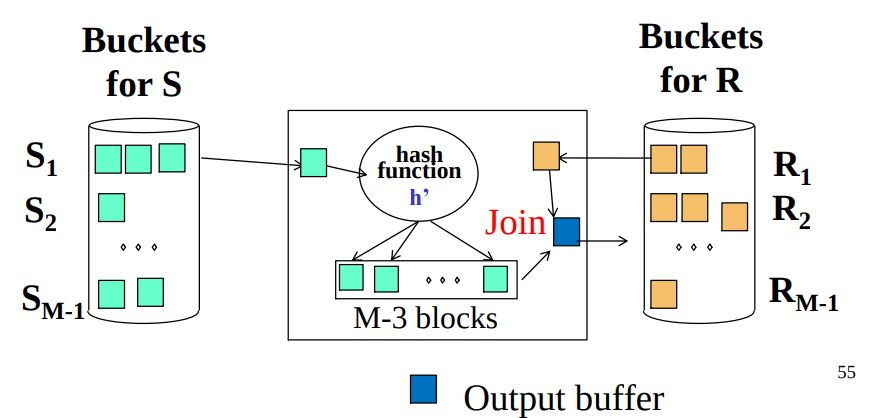
Index-Based Algorithms
The existence of an index on one ore more attributes of a relation makes available some algorithms that would not be feasible without the index • Useful for selection operations • Also, algorithms for join and other binary operations use indexes to good advantage
Index-Based Selection, $\sigma_{a=v}(R)$
- Assumption: We here ignored the cost of reading index blocks
-
Cost
- Clustered index on attribute $a$: $B(R)/V(R,a)$
- Unclustered index on attribute $a$: $T(R)/V(R,a)$
Index-Based Join, $R\bowtie S$
- Assumption: Assume $S$ has an index on the join attribute
- Steps
- Iterate over $R$, for each tuple, fetch corresponding tuple $s$ from $S$
-
Cost
- Clustered index $$B(R) + \frac{T(R)B(S)}{V(S,a)}$$
- Unclustered index $$B(R) + \frac{T(R)T(S)}{V(S,a)}$$
- Indexed-Based Join vs NLJ
- Recall the cost for Nested Loop Join (NLJ), assume both $R$ and $S$ are clustered $$B(R) + \frac{B(R)B(S)}{M-2}$$
- Index-Based wins NLJ if:
- $$\frac{T(R)}{V(S,a)} < \frac{B(R)}{M-2}$$, or
- $$V(S,a) > (M-2) \cdot \frac{T(R)}{B(R)}$$
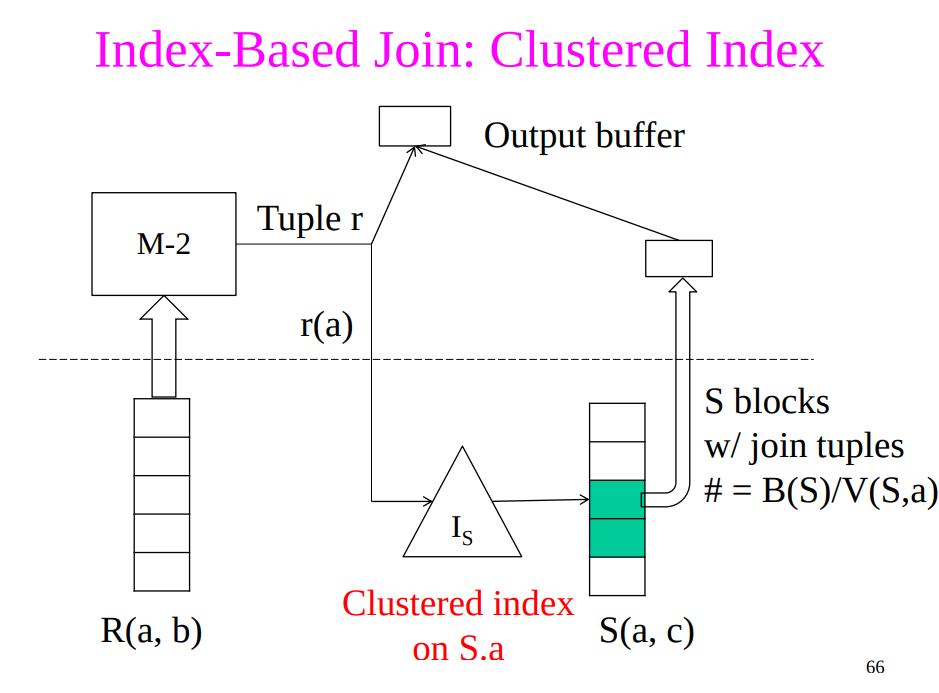
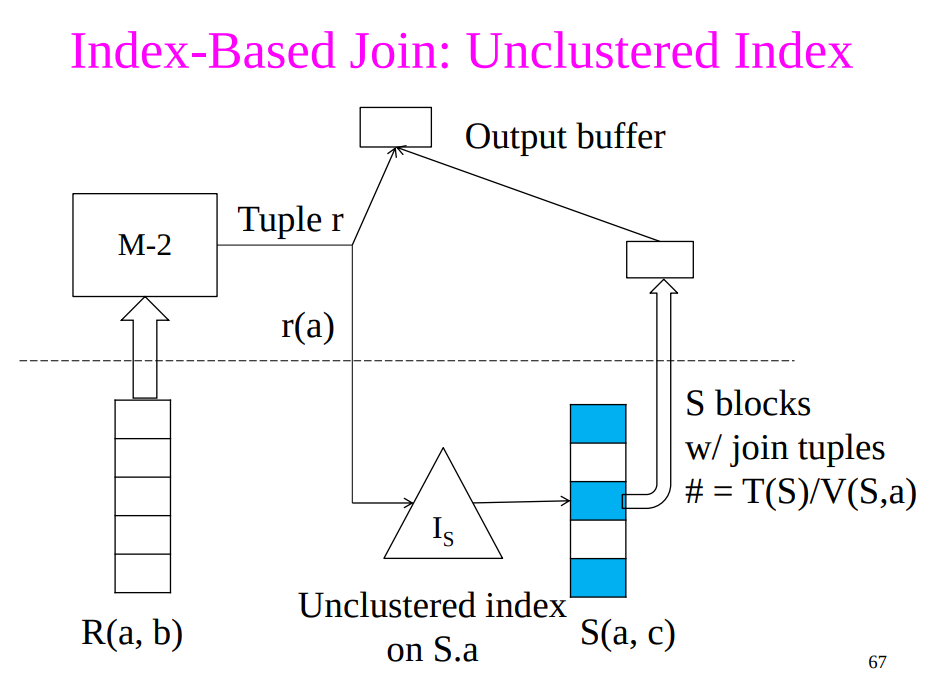
Index-Based Join with Two Indices
- Assumption: Assume both $R$ and $S$ have a clustered index (e.g., B+-tree) on the join attribute
- Then can perform a sort-merge join where sorting is already done (for free)
- Cost: $B(R) + B(S)$